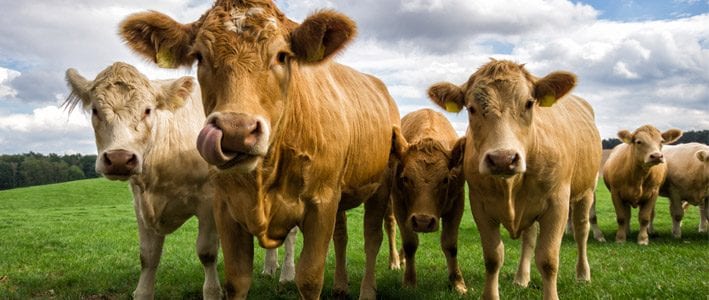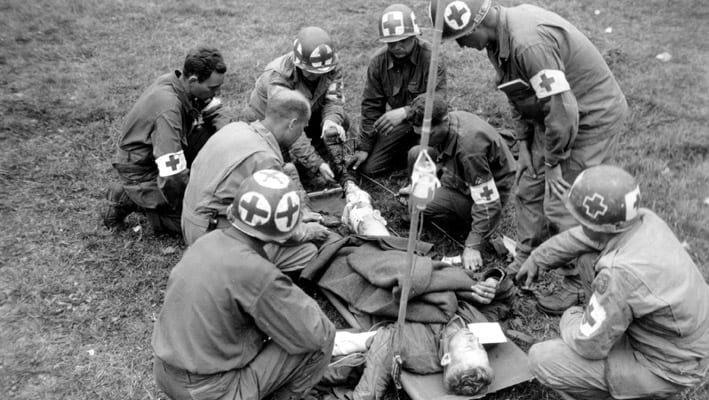© alphafotos / Adobe Stock
The ongoing red meat debate looks set to continue for the foreseeable future, as scientists argue over whether livestock farming is bad for the environment. Some newspapers have reported that the carbon footprint of eating meat (especially beef) is excessively high.
A study published by the United Nations has claimed the amount of carbon dioxide released into the atmosphere (causing damage to the ozone layer) as a result of farming animal’s accounts for 14.5% of all greenhouse gas emissions.
In addition, a research paper co-published by scientists at Oxford University and Swiss research company Agroscope said there was a rising demand for meat, mainly due to population growth. It claimed livestock production accounted for 83% of global farmland usage, yet it contributed on average only 37% of our protein intake and 18% of calories.
Media “anti-meat”
Given these studies, it comes as no surprise that the media appears to have become increasingly anti-meat. The Guardian carried an editorial claiming avoiding meat and dairy was the single biggest way of reducing our impact on the earth.
Numerous articles across a broad spectrum of media have promoted eating vegan and vegetarian diets. Of course, the subject of what we should be eating to reduce the damaging effects on the environment is an important one. Yet at present, the debate has largely been limited to advice on stopping eating meat, with little exploration of what constitutes food system sustainability.
Although it’s crucial that we’re eco-friendly, does this mean we should be eating less meat, or maybe even no meat at all?
Now, a growing community of academics, scientists and farmers have begun to turn the anti-meat tide by introducing a radical new school of thought that suggests rearing livestock and eating red meat can provide a solution to climate change.
They claim that the way forward is by having well-managed livestock that produce healthier soil – that actually takes carbon dioxide out of the atmosphere.
Mob grazing
The idea is to get the farm animals to copy the movements of wild herding animals. If they lived in the wild, sheep and cows would move in a herd to look for fresh grazing land and to keep predators at a distance.
This behaviour among captive animals is called “mob grazing” by its supporters, who claim it would enable farmers to increase meat production, without the use of chemicals or grains, thus producing healthier beef.
Under the current conventional grazing system, livestock will graze on the same patch of grassland for anything from a few weeks to months. They will graze heavily on plants they enjoy, so over time, these plants will be overgrazed, making them weak and susceptible to being stifled by weeds.
Hazards of fertiliser
This leads farmers to put down chemical fertiliser to kill the weeds and get the grass growing again – fertiliser replaces the natural nutrients that soil usually provides. The soil’s organic matter reduces and over time, the diversity of the species of grass also declines.
The heavily fertilised grass leaves the livestock undernourished, so then the farmer must add grain to the animals’ diet to fatten them up, or to ensure they keep on producing high-quality milk. This type of industrial farming prompts condemnation from environmentalists.
It damages the planet on many levels: fossil fuel is needed to produce the chemical fertilisers, while they can also release hazardous nitrous oxide into the earth’s atmosphere. Having to feed grain to the livestock is seen as a waste of resources by campaigners, while the grazing cattle release tons of methane into the air.
Scientists have said that the increase in methane gas recorded in the atmosphere since the late 1970s is contributing to making the earth warmer, reducing the amount of protective ozone over Antarctica and leading to eventual catastrophe for our planet.
Rotate the herd
Supporters of the mob-grazing system say it is beneficial to the planet rather than damaging. Rotating the herd enables the pastures to recover and it also stores carbon in the soil.
The farmer puts the cattle out to graze on one acre of grass for a day. This will force them to eat everything, rather than just picking out their favourite grasses. The following day, they are moved on to a different acre and the same process is repeated.
The herd won’t graze again on the first acre of grass for several months. This gives it a long rest period, which means the grass grows taller, stifles the weeds and encourages a diversity of plants. There will be no need to use fertiliser and the animals won’t need to eat grain, as they will consume the necessary nutrients simply by grazing.
The carbon-storing process is the key to the beef-lovers’ innovative solution to climate change. Mob grazing has been employed for years in Africa and studies have shown the soil fertility has increased – as has the amount of carbon stored in the soil.
Introducing this technique on a widespread basis in the UK would have a major impact on farmers, who would have to rethink their mindset when it comes to running their business.
“Bigger picture”
The Sustainable Food Trust points out that one-sided anti-meat reports “fail to see the bigger picture”. Around 25% of the world’s population lives in dryland regions, continually threatened by droughts. Farmers who depended totally on crops wouldn’t have any food if the rain didn’t fall. Farming livestock provides them with a buffer against starvation in times of drought.
While most people in the UK have cars and central heating, or fly abroad, leading to an increase in our own carbon footprint, people living in the global south dry-lands have a carbon footprint which is only a fraction of our own.
Hence pro-meat campaigners say the headlines about the percentage of land used for livestock and the supposed effect on the global footprint can be “misleading” when one considers the bigger picture.
Scientist Joseph Poore has written a research paper about the differences in emissions associated with the different production systems for beef and suggests a major objective should be to improve the methods with the largest carbon footprint, rather than calling for a reduction in red meat consumption.
1COLD specialises in the supply of temperature-controlled, hygienic environments, including cold stores suitable for storing meats and other perishable foodstuffs. Please contact us for more information.




